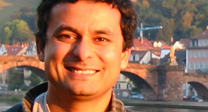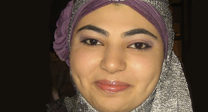Image Analysis
SCI's imaging work addresses fundamental questions in 2D and 3D image processing, including filtering, segmentation, surface reconstruction, and shape analysis. In low-level image processing, this effort has produce new nonparametric methods for modeling image statistics, which have resulted in better algorithms for denoising and reconstruction. Work with particle systems has led to new methods for visualizing and analyzing 3D surfaces. Our work in image processing also includes applications of advanced computing to 3D images, which has resulted in new parallel algorithms and real-time implementations on graphics processing units (GPUs). Application areas include medical image analysis, biological image processing, defense, environmental monitoring, and oil and gas.
Ross Whitaker
Segmentation
Chris Johnson
Diffusion Tensor AnalysisFunded Research Projects:
Publications in Image Analysis:
 Relating Metopic Craniosynostosis Severity to Intracranial Pressure, J.D. Blum, J. Beiriger, C. Kalmar, R.A. Avery, S. Lang, D.F. Villavisanis, L. Cheung, D.Y. Cho, W. Tao, R. Whitaker, S.P. Bartlett, J.A. Taylor, J.A. Goldstein, J.W. Swanson. In The Journal of Craniofacial Surgery, 2022. DOI: 10.1097/SCS.0000000000008748 Purpose: Methods:
Children with nonsyndromic single-suture metopic synostosis were prospectively enrolled and underwent optical coherence tomography to measure optic nerve head morphology. Preoperative head computed tomography scans were assessed for endocranial bifrontal angle as well as scaled metopic synostosis severity score (MSS) and cranial morphology deviation score determined by CranioRate, an automated severity classifier. Results:
Forty-seven subjects were enrolled between 2014 and 2019, at an average age of 8.5 months at preoperative computed tomography and 11.8 months at index procedure. Fourteen patients (29.7%) had elevated optical coherence tomography parameters suggestive of elevated ICP at the time of surgery. Ten patients (21.3%) had been diagnosed with developmental delay, eight of whom demonstrated elevated ICP. There were no significant associations between measures of metopic severity and ICP. Metopic synostosis severity score and endocranial bifrontal angle were inversely correlated, as expected (r=−0.545, P<0.001). A negative correlation was noted between MSS and formally diagnosed developmental delay (r=−0.387, P=0.008). Likewise, negative correlations between age at procedure and both MSS and cranial morphology deviation was observed (r=−0.573, P<0.001 and r=−0.312, P=0.025, respectively). Conclusions:
Increased metopic severity was not associated with elevated ICP at the time of surgery. Patients who underwent later surgical correction showed milder phenotypic dysmorphology with an increased incidence of developmental delay. |
  Characterization of uncertainties and model generalizability for convolutional neural network predictions of uranium ore concentrate morphology C. A. Nizinski, C. Ly, C. Vachet, A. Hagen, T. Tasdizen, L. W. McDonald. In Chemometrics and Intelligent Laboratory Systems, Vol. 225, Elsevier, pp. 104556. 2022. ISSN: 0169-7439 DOI: https://doi.org/10.1016/j.chemolab.2022.104556 As the capabilities of convolutional neural networks (CNNs) for image classification tasks have advanced, interest in applying deep learning techniques for determining the natural and anthropogenic origins of uranium ore concentrates (UOCs) and other unknown nuclear materials by their surface morphology characteristics has grown. But before CNNs can join the nuclear forensics toolbox along more traditional analytical techniques – such as scanning electron microscopy (SEM), X-ray diffractometry, mass spectrometry, radiation counting, and any number of spectroscopic methods – a deeper understanding of “black box” image classification will be required. This paper explores uncertainty quantification for convolutional neural networks and their ability to generalize to out-of-distribution (OOD) image data sets. For prediction uncertainty, Monte Carlo (MC) dropout and random image crops as variational inference techniques are implemented and characterized. Convolutional neural networks and classifiers using image features from unsupervised vector-quantized variational autoencoders (VQ-VAE) are trained using SEM images of pure, unaged, unmixed uranium ore concentrates considered “unperturbed.” OOD data sets are developed containing perturbations from the training data with respect to the chemical and physical properties of the UOCs or data collection parameters; predictions made on the perturbation sets identify where significant shortcomings exist in the current training data and techniques used to develop models for classifying uranium process history, and provides valuable insights into how datasets and classification models can be improved for better generalizability to out-of-distribution examples. |
  Translational computer science at the scientific computing and imaging institute C. R. Johnson. In Journal of Computational Science, Vol. 52, pp. 101217. 2021. ISSN: 1877-7503 DOI: https://doi.org/10.1016/j.jocs.2020.101217 The Scientific Computing and Imaging (SCI) Institute at the University of Utah evolved from the SCI research group, started in 1994 by Professors Chris Johnson and Rob MacLeod. Over time, research centers funded by the National Institutes of Health, Department of Energy, and State of Utah significantly spurred growth, and SCI became a permanent interdisciplinary research institute in 2000. The SCI Institute is now home to more than 150 faculty, students, and staff. The history of the SCI Institute is underpinned by a culture of multidisciplinary, collaborative research, which led to its emergence as an internationally recognized leader in the development and use of visualization, scientific computing, and image analysis research to solve important problems in a broad range of domains in biomedicine, science, and engineering. A particular hallmark of SCI Institute research is the creation of open source software systems, including the SCIRun scientific problem-solving environment, Seg3D, ImageVis3D, Uintah, ViSUS, Nektar++, VisTrails, FluoRender, and FEBio. At this point, the SCI Institute has made more than 50 software packages broadly available to the scientific community under open-source licensing and supports them through web pages, documentation, and user groups. While the vast majority of academic research software is written and maintained by graduate students, the SCI Institute employs several professional software developers to help create, maintain, and document robust, tested, well-engineered open source software. The story of how and why we worked, and often struggled, to make professional software engineers an integral part of an academic research institute is crucial to the larger story of the SCI Institute’s success in translational computer science (TCS). |
  Bridge Simulation on Lie Groups and Homogeneous Spaces with Application to Parameter Estimation Subtitled “arXiv:2112.00866,” M. Højgaard Jensen, L. Hilgendorf, S. Joshi, S. Sommer. 2021. |
  Prediction of Femoral Head Coverage from Articulated Statistical Shape Models of Patients with Developmental Dysplasia of the Hip P. R. Atkins, P. Agrawal, J. D. Mozingo, K. Uemura, K. Tokunaga, C. L. Peters, S. Y. Elhabian, R. T. Whitaker, A. E. Anderson. In Journal of Orthopaedic Research, Wiley, 2021. DOI: 10.1002/jor.25227 Developmental dysplasia of the hip (DDH) is commonly described as reduced femoral head coverage due to anterolateral acetabular deficiency. Although reduced coverage is the defining trait of DDH, more subtle and localized anatomic features of the joint are also thought to contribute to symptom development and degeneration. These features are challenging to identify using conventional approaches. Herein, we assessed the morphology of the full femur and hemi-pelvis using an articulated statistical shape model (SSM). The model determined the morphological and pose-based variations associated with DDH in a population of Japanese females and established which of these variations predict coverage. Computed tomography images of 83 hips from 47 patients were segmented for input into a correspondence-based SSM. The dominant modes of variation in the model initially represented scale and pose. After removal of these factors through individual bone alignment, femoral version and neck-shaft angle, pelvic curvature, and acetabular version dominated the observed variation. Femoral head oblateness and prominence of the acetabular rim and various muscle attachment sites of the femur and hemi-pelvis were found to predict 3D CT-based coverage measurements (R2=0.5-0.7 for the full bones, R2=0.9 for the joint). |
  Validation of Artificial Intelligence Severity Assessment in Metopic Craniosynostosis A. Junn, J. Dinis, S. C. Hauc, M. K. Bruce, K. E. Park, W. Tao, C. Christensen, R. Whitaker, J. A. Goldstein, M. Alperovich. In The Cleft Palate-Craniofacial Journal, SAGE Publications, 2021. DOI: https://doi.org/10.1177/10.1177/10556656211061021 Objective Design
Preoperative computed tomography (CT) scans of patients who underwent surgical correction of metopic craniosynostosis were quantitatively analyzed for severity. Each scan was manually measured to derive manual severity scores and also received a scaled metopic severity score (MSS) assigned by the machine learning algorithm. Regression analysis was used to correlate manually captured measurements to MSS. ROC analysis was performed for each severity metric and were compared to how accurately they distinguished cases of metopic synostosis from controls.Results
In total, 194 CT scans were analyzed, 167 with metopic synostosis and 27 controls. The mean scaled MSS for the patients with metopic was 6.18 ± 2.53 compared to 0.60 ± 1.25 for controls. Multivariable regression analyses yielded an R-square of 0.66, with significant manual measurements of endocranial bifrontal angle (EBA) (P = 0.023), posterior angle of the anterior cranial fossa (p < 0.001), temporal depression angle (P = 0.042), age (P < 0.001), biparietal distance (P < 0.001), interdacryon distance (P = 0.033), and orbital width (P < 0.001). ROC analysis demonstrated a high diagnostic value of the MSS (AUC = 0.96, P < 0.001), which was comparable to other validated indices including the adjusted EBA (AUC = 0.98), EBA (AUC = 0.97), and biparietal/bitemporal ratio (AUC = 0.95).Conclusions
The machine learning algorithm offers an objective assessment of morphologic severity that provides a reliable composite impression of severity. The generated score is comparable to other severity indices in ability to distinguish cases of metopic synostosis from controls.
|
  Determining the Composition of a Mixed Material with Synthetic Data C. Ly, C. A. Nizinski, A. Toydemir, C. Vachet, L. W. McDonald, T. Tasdizen. In Microscopy and Microanalysis, Cambridge University Press, pp. 1--11. 2021. DOI: 10.1017/S1431927621012915 Determining the composition of a mixed material is an open problem that has attracted the interest of researchers in many fields. In our recent work, we proposed a novel approach to determine the composition of a mixed material using convolutional neural networks (CNNs). In machine learning, a model “learns” a specific task for which it is designed through data. Hence, obtaining a dataset of mixed materials is required to develop CNNs for the task of estimating the composition. However, the proposed method instead creates the synthetic data of mixed materials generated from using only images of pure materials present in those mixtures. Thus, it eliminates the prohibitive cost and tedious process of collecting images of mixed materials. The motivation for this study is to provide mathematical details of the proposed approach in addition to extensive experiments and analyses. We examine the approach on two datasets to demonstrate the ease of extending the proposed approach to any mixtures. We perform experiments to demonstrate that the proposed approach can accurately determine the presence of the materials, and sufficiently estimate the precise composition of a mixed material. Moreover, we provide analyses to strengthen the validation and benefits of the proposed approach. |
 Computational Image Techniques for Analyzing Lanthanide and Actinide Morphology, C. A. Nizinski, C. Ly, L. W. McDonald IV, T. Tasdizen. In Rare Earth Elements and Actinides: Progress in Computational Science Applications, Ch. 6, pp. 133-155. 2021. DOI: 10.1021/bk-2021-1388.ch006 This chapter introduces computational image analysis techniques and how they may be used for material characterization as it pertains to lanthanide and actinide chemistry. Specifically, the underlying theory behind particle segmentation, texture analysis, and convolutional neural networks for material characterization are briefly summarized. The variety of particle segmentation techniques that have been used to effectively measure the size and shape of morphological features from scanning electron microscope images will be discussed. In addition, the extraction of image texture features via gray-level co-occurrence matrices and angle measurement techniques are described and demonstrated. To conclude, the application of convolutional neural networks to lanthanide and actinide materials science challenges are described with applications for image classification, feature extraction, and predicting a materials morphology discussed. |
 A Gaussian Process Model for Unsupervised Analysis of High Dimensional Shape Data, W. Tao, R. Bhalodia, R. Whitaker. In Machine Learning in Medical Imaging, Springer International Publishing, pp. 356--365. 2021. DOI: 10.1007/978-3-030-87589-3_37 Applications of medical image analysis are often faced with the challenge of modelling high-dimensional data with relatively few samples. In many settings, normal or healthy samples are prevalent while pathological samples are rarer, highly diverse, and/or difficult to model. In such cases, a robust model of the normal population in the high-dimensional space can be useful for characterizing pathologies. In this context, there is utility in hybrid models, such as probabilistic PCA, which learns a low-dimensional model, commensurates with the available data, and combines it with a generic, isotropic noise model for the remaining dimensions. However, the isotropic noise model ignores the inherent correlations that are evident in so many high-dimensional data sets associated with images and shapes in medicine. This paper describes a method for estimating a Gaussian model for collections of images or shapes that exhibit underlying correlations, e.g., in the form of smoothness. The proposed method incorporates a Gaussian-process noise model within a generative formulation. For optimization, we derive a novel expectation maximization (EM) algorithm. We demonstrate the efficacy of the method on synthetic examples and on anatomical shape data. |
  A Nonparametric Approach for Estimating Three-Dimensional Fiber Orientation Distribution Functions (ODFs) in Fibrous Materials A. Rauff, L.H. Timmins, R.T. Whitaker, J.A. Weiss. In IEEE Transactions on Medical Imaging, 2021. DOI: 10.1109/TMI.2021.3115716 Many biological tissues contain an underlying fibrous microstructure that is optimized to suit a physiological function. The fiber architecture dictates physical characteristics such as stiffness, diffusivity, and electrical conduction. Abnormal deviations of fiber architecture are often associated with disease. Thus, it is useful to characterize fiber network organization from image data in order to better understand pathological mechanisms. We devised a method to quantify distributions of fiber orientations based on the Fourier transform and the Qball algorithm from diffusion MRI. The Fourier transform was used to decompose images into directional components, while the Qball algorithm efficiently converted the directional data from the frequency domain to the orientation domain. The representation in the orientation domain does not require any particular functional representation, and thus the method is nonparametric. The algorithm was verified to demonstrate its reliability and used on datasets from microscopy to show its applicability. This method increases the ability to extract information of microstructural fiber organization from experimental data that will enhance our understanding of structure-function relationships and enable accurate representation of material anisotropy in biological tissues. |







